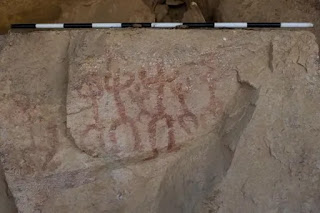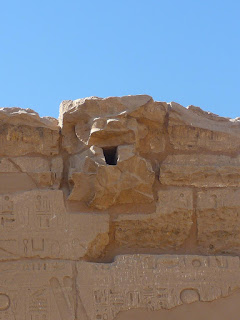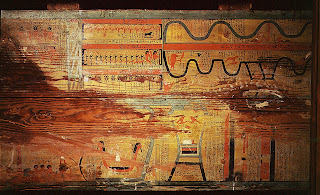Tuesday, January 28, 2020
Ancient Egypt News 01/27/2020
GEM Receives 356 Artifacts from Tut,Ramses II, Thutmose III, Ptah Treasures
The general supervisor of the Grand Egyptian Museum Atef Moftah announced that the museum has received a collection of 356 artifacts from the Egyptian Museum in Tahrir, among which 57 artifacts from the treasures of the Golden King Tutankhamun and 11 pieces will be displayed on the grand staircase.
Director General of the Grand Egyptian Museum for Antiquities affairs Dr. Al-Tayeb Abbas, said that the one of the most important of these artifacts is a statue of god Ptah, whose weights range between 5 and 6 tons, which will be displayed on the grand staircase within another distinguished group of royal statues.
Shocking Truth behind Takabuti’s Death Revealed
Takabuti, the famous ancient Egyptian mummy on display at the Ulster Museum, suffered a violent death from a knife attack, a team of experts from National Museums NI, University of Manchester, Queen’s University Belfast and Kingsbridge Private Hospital have revealed.
The team, whose findings are made public on the 185 year anniversary of Takabuti’s unwrapping in 1835, also show that her DNA is more genetically similar to Europeans rather than modern Egyptian populations.
The team show Takabuti had an extra tooth - 33 instead of 32 - something which only occurs in 0.02% of the population and an extra vertebrae, which only occurs 2% of the population.
Cave Covered in Ancient Egyptian Paintings of Donkeys and People Discovered by Accident
MINISTRY OF TOURISM AND ANTIQUITIES
A chance encounter has led to the discovery of a small sandstone cave in the middle of the Sinai in Egypt. The cave is colorfully decorated with paintings of people and donkeys, some of which date back to 10,000 BCE.
Egypt's Ministry of Tourism and Antiquities say they have now finished documenting all the the inscriptions, announcing the news via Facebook. According to the ministry, the cave was discovered by chance approximately 30 kilometers (19 miles) north from the city St. Catherine and 60 kilometers southeast from the Hathor temple Sarabit el-Khadem following the advice of a "desert adventurer."
The Mummy Speaks! Hear Sounds From the Voice of an Ancient Egyptian Priest
Credit...Leeds Museums and Galleries
In life, Nesyamun was an Egyptian priest who sang and chanted words of worship at the Karnak temple in Thebes. In death, he was ritually mummified and sealed in a coffin with the inscription “Nesyamun, true of voice.” Now, some 3,000 years into the afterlife and with the aid of a 3-D-printed vocal tract, Nesyamun can once again be heard.
“He had this wish that his voice would somehow continue into perpetuity,” said David Howard, a speech scientist at Royal Holloway, University of London.
And you would be remiss not to read the counterpoint to this "discovery." Attempts to Reconstruct a Mummy’s Voice Are Cursed, which makes the argument after a group of British researchers claimed to synthesize the voice of Egyptian priest Nesyamun’s 3,000-year-old remains, it leads to questions about the ethics of Egyptology.
Egyptologists Open Newly-Discovered Pyramid
Monday, January 13, 2020
Ancient Egypt News: Astronomy 01/13/2020
Rain, Rain, Go Away: Dealing with Wastewater and Rain in Ancient Egypt
Photo: H. Köpp-Junk
An efficient drainage system for rain and wastewater is important for every complex society. Even today, water discharge is a central issue in Egypt, especially in the global metropolis Cairo. While irrigation is frequently discussed in Egyptology, dewatering systems are only rarely investigated.
No known depictions or textual sources mention dewatering systems, but there are a variety of archeological finds that elucidate the range, innovation, and high quality of ancient Egyptian engineering skills long before the arrival of Roman water management techniques.
Egyptian methods for dewatering in temples, tombs, and houses are well attested from the middle of the 3rd millennium BCE onward. For example, dewatering systems are used for rain as well as wastewater from bathrooms and kitchens, and there is evidence for these systems in houses, temples, and tombs. Moreover, used water also had to be removed from industrial sites such as those used for dyeing, washhouses, and mummification workshops, since considerable amounts of water were necessary during the embalming process.
Experts Fear Damage to Ancient Egyptian Artifacts en Route to Tahrir Square
Photo ©Michalea Moore 2017
Egypt's recent decision to transport ancient Pharaonic artifacts to a traffic circle in the congested heart of Cairo has fueled fresh controversy over the government's handling of its archaeological heritage.
Cairo has some of the worst air pollution in the world, according to recent studies. Archaeologists and heritage experts fear vehicle exhaust will damage the four ram-headed sphinxes and an obelisk, currently en route to their new home in Tahrir Square.
This Week’s Hubble Image Illustrates an Ancient Egyptian Myth
NASA / ESA / Hubble / I. Karachentsev et al.
This week’s Hubble image shows an elegant spiral galaxy named NGC 4455, located in the northern constellation of Coma Berenices (Berenice’s Hair).
This unusually named constellation took its title from an Egyptian queen who ruled from around 250 BC. The Hubble astronomers explained the myth for which the constellation is named: “The story of Queen Berenice II is an interesting one,” the astronomers said. “A ruling queen of the ancient Greek city of Cyrene in modern-day Libya, and later a queen of Ptolemaic Egypt through her marriage to her cousin Ptolemy III Euergetes, Berenice became known for sacrificing locks of her hair as an offering to ensure her husband’s safe return from battle. Her husband did indeed return safely and her hair, which she had left in a Zephyrium temple, had disappeared — it had apparently been stolen and placed among the stars
Tourists Flock to Egypt’s Hatshepsut Temple to Catch Glimpse of Rare Astronomical Phenomenon
Photo ©Michalea Moore 2017
Tourists in Egypt flocked to Queen Hatshepsut Temple on Monday to witness the sun fall perpendicular on the holy shrines of the ancient monument, a unique astronomical phenomenon marking the ancient Egyptian festival of the Goddess Hathor.
A group of Japanese tourists visited the temple, which is located west of Egypt’s Luxor, in order to witness the phenomenon, with dozens of visitors from countries around the world taking photos inside the complex.
Monday, January 6, 2020
Ancient Egypt News: The GEM is Coming 01/06/2020
90 Percent of GEM work is Finished
File - Grand Egyptian Museum
Ministry of Tourism and Antiquities announced that about more than 90 percent of the Grand Egyptian Museum work was finalized. GEM is expected to be inaugurated in the last quarter of 2020.
The inauguration of the Grand Egyptian Museum is one of the main events that Egypt and the whole world is waiting for in 2020.
About 49,603 artifacts were moved to the Grand Egyptian Museum so far.
Salvaging Khufu’s Second Solar Boat
© Khufu Second Boat Project
In the scorching heat of the Giza plateau, the Egyptian Ministry of Antiquities and a team from Waseda University in Japan are engaged in the daunting task of lifting a 4,700-year-old wooden ship from a pit in the ground, just a few meters south of Khufu’s great pyramid.
This is no ordinary excavation; the wooden pieces from the 42-meter-long boat are so delicate that the archaeologists cannot simply remove them from the ground without extensive onsite conservation.
Here's a picture in 2017 I took of the first solar boat at the Solar Boat Museum. If you go to Egypt, plan to visit the museum, which is right outside the Great Pyramid.
© Michalea Moore
Grand Egyptian Museum to Open End of 2020, Ticket Prices Initially Announced
AP Photo/Amr Nabil
The site of the Grand Egyptian Museum. (AP Photo/Amr Nabil)
Egypt’s anticipated national project, the Grand Egyptian Museum, is set to open at the end of 2020, revealed Minister of Tourism and Antiquities Khaled El Enany.
Moreover, the museum’s initial ticket pricing for foreigners has been set to 400 EGP ($US 25), 200 EGP for students ($US 12.5) according El Watan and Daily News Egypt.
How Cleopatra Became a Canvas for Society's Anxieties
Wikimedia Commons
Two-thousand years after her death, Cleopatra continues to enthrall us. Earlier this year, the British tabloid The Daily Star reported that a new movie about this last Pharaoh of Egypt was in the works. According to an anonymous source, the movie will be "a dirty, bloody, political thriller told from a feminist perspective," as opposed to the movie Cleopatra of 1963 starring Elizabeth Taylor, which had been a historical epic.
An Afterlife So Perilous, You Needed a Guidebook
Werner Forman/Universal Images Group, via Getty Images
Archaeologists unearthed the remains of a 4,000-year-old “Book of Two Ways” — a guide to the Egyptian underworld, and the earliest copy of the first illustrated book.
When it comes to difficult travel, no journey outside New York City’s subway system rivals the ones described in “The Book of Two Ways,” a mystical road map to the ancient Egyptian afterlife.
This users’ guide, a precursor to the corpus of Egyptian funerary texts known as “The Book of the Dead,” depicted two zigzagging paths by which, scholars long ago concluded, the soul, having left the body of the departed, could navigate the spiritual obstacle course of the Underworld and reach Rostau — the realm of Osiris, the god of death, who was himself dead. If you were lucky enough to get the go-ahead from Osiris’ divine tribunal, you would become an immortal god.
Egypt Amazes the World with 2019 Archaeological Discoveries
Over the last two years, a large number of new discoveries in Egypt have grabbed the world’s attention. Egypt Today Magazine will provide its readers with a capsule of all the discoveries that occurred in 2019.
Bees!
This is from The Tears of Re, Beekeeping in Ancient Egypt by Gene Kritsky.

Subscribe to:
Posts (Atom)


















